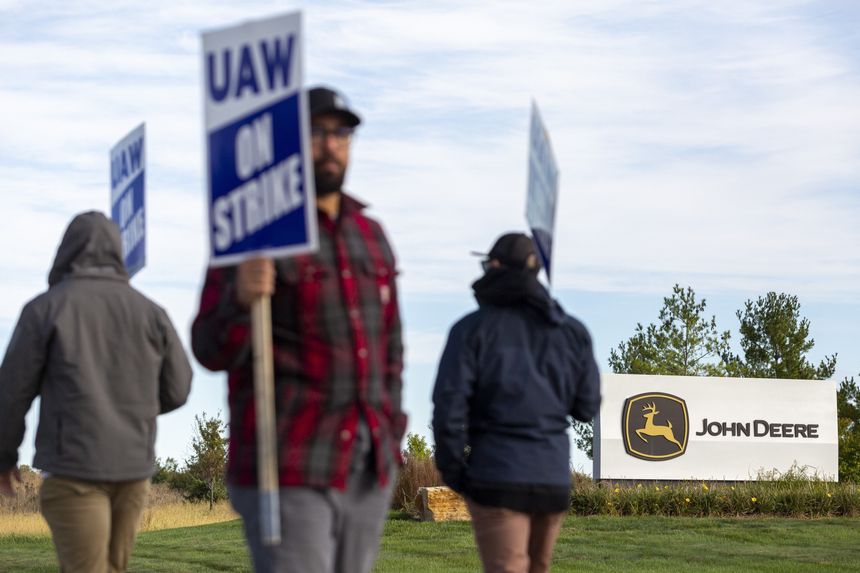
Labor is scarce in the United States, while demand for talent remains high. This has led to some businesses hiring illegal immigrants who are willing to work long hours at low pay. To combat this issue, unions have increased their push against employers with labor shortages.
Big Labor and the Supply Shortage is a problem that has been present for a while. The article gives an overview of the issue with some potential solutions.
Deere & Co. employees carry banners outside the John Deere Des Moines Works factory in Ankeny, Iowa, during a strike on Oct. 15.
Flickr/Bloomberg News/Rachel Mummey
Forget everything you’ve heard about organized labor’s demise. In the midst of today’s national labor shortage, a slew of strikes around the country are emphasizing the strength of unions, with potentially disastrous ramifications for the country’s ongoing supply woes.
The largest walkout occurred after midnight on Thursday, when over 10,000 Deere & Co. workers went on strike. Workers decisively rejected an agreement reached by their United Auto Workers delegates for salary and benefit increases on Oct. 10.
Employees could have jumped at the conditions they turned down in a different year. According to the firm, by 2027, the average yearly compensation for a factory worker will have risen to $72,000 from $60,000. Employees would also be eligible for one-time bonuses and improved retirement benefits.
However, a number of reasons are bolstering worker expectations. Inflation has risen to 5.4 percent in the last year, eroding present salaries and encouraging workers to demand larger rises. As long as inflation remains, this is likely to extend to other businesses and sectors. As companies are realizing, a labor scarcity has escalated pay expectations and union power.
Thousands of more employees have joined the picket line in recent months as a result of these conditions. Employees at Frito-Lay got a bigger rise in July, as well as the termination of certain grueling work arrangements. After a three-week strike, carpenters in Washington state were able to get a 21 percent wage hike this month. More than 1,400 Kellogg workers were let off from four sites around the nation last week.
These strikes were timed to coincide with an economic downturn. Between recovered demand and insufficient labor, supply chains are being stretched, resulting in production limitations in a variety of sectors. Salesforce forecasts that 350,000 absent employees in the retail industry would cost firms $223 billion by the Christmas season.
For companies and consumers alike, work stoppages are exacerbating the problem. Farmers anticipate delays in repairs and delivery while Deere handles its strike, according to the Des Moines Register. Kellogg’s stock dropped when employees walked out, despite the company’s CEO saying in May that he was delaying price hikes.
The victim narrative of unions and their political backers is upended by this exhibition of labor strength. For a number of reasons, including the example of auto and steel businesses burdened by weak union contracts and legacy expenses, union membership as a percentage of the private workforce has declined over time. Thousands of union auto workers lost their employment in right-to-work states in the South, while non-union employees profited.
Despite this, unions continue to wield substantial power in structured sectors. Unions find it advantageous to present themselves as victims in order to acquire negotiating leverage from their political supporters. Big Labor’s major lobby, the AFL-CIO, has spearheaded the charge to approve the PRO Act, which would give unions the upper hand over management. Despite workers’ proven success on the picket line, union activists and Democrats want state right-to-work laws repealed and employers’ ability to challenge union negotiating demands limited.
***
President Biden, a self-proclaimed labor supporter who is now suffering electoral harm as a result of soaring prices and acute supply shortages, isn’t immune to the recent strikes. On Wednesday, the President signed arrangements with shops to speed up delivery and clear congested ports. We’re curious as to what he promised the Long Beach longshoremen in exchange.
We believe that unions and management can solve their own issues, and that pay increases in a tight labor market are good when they represent productivity advances. The issue emerges when pay expectations stifle a company’s capacity to compete in the marketplace, putting employees at risk of losing their employment in the future.
Meanwhile, the truth is that the more employees go on strike, the longer it will take for supply to catch up to demand in today’s market.
What is the source of everything’s high price, and what will the political cost be?
Dow Jones & Company, Inc. All Rights Reserved. Copyright 2021 Dow Jones & Company, Inc. 87990cbe856818d5eddac44c7b1cdeb8
The print version of the October 18, 2021, was published.
The labor shortage in the United States is expected to be a major issue in 2021. The article explains why this could happen and what it means for the future of the country. Reference: why is there a labor shortage 2021.
Related Tags
- labor shortage statistics 2021
- unskilled labor shortage 2021
- u.s. labor shortage statistics
- labor shortage myth
- labour shortage countries 2021



